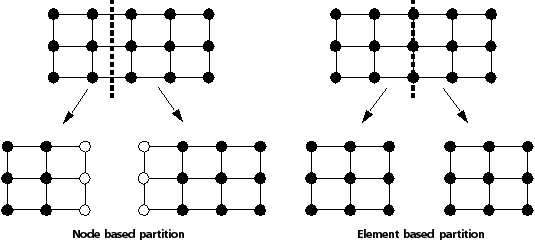Any three-dimensional mesh can be partitioned using either node-based or element-based partitioning. Node-based partitioning divides the mesh across element faces; that is, between nodal locations. Element-based partitioning divides the mesh along element faces without dividing elements themselves; that is, at nodal locations.
CFX uses node-based partitioning because this is consistent with the node-based linear solver. The following partitioners are available:
MeTiS
Recursive Coordinate Bisection
Optimized Recursive Coordinate Bisection
Simple Assignment
User Defined Direction
Directional Recursive Coordinate Bisection
Junction Box
Radial
Circumferential.
Not all nodes in a given case require the same amount of computational
effort. For example, a node on a GGI boundary requires a larger assembly
effort within the solver than a node that is not on a GGI boundary.
To take account of this, the CFX-Solver does not weight all nodes
equally during partitioning—a partition with a lot of nodes
on GGI interfaces will generally be assigned fewer nodes in total
than one that does not have many nodes on GGI interfaces. There is
an expert control parameter, ggi vertex weighting value,
that controls the weighting applied to GGI vertices during partitioning.
For more information, see Expert Control Parameters.
In order to account for the different costs per vertex depending on the
mesh element type, it is also possible to apply partition node weighting
that adjusts the node counts among the partitions considering the
mesh element types. For details, see
Partition Node Weighting in the CFX-Solver Manager User's Guide.



